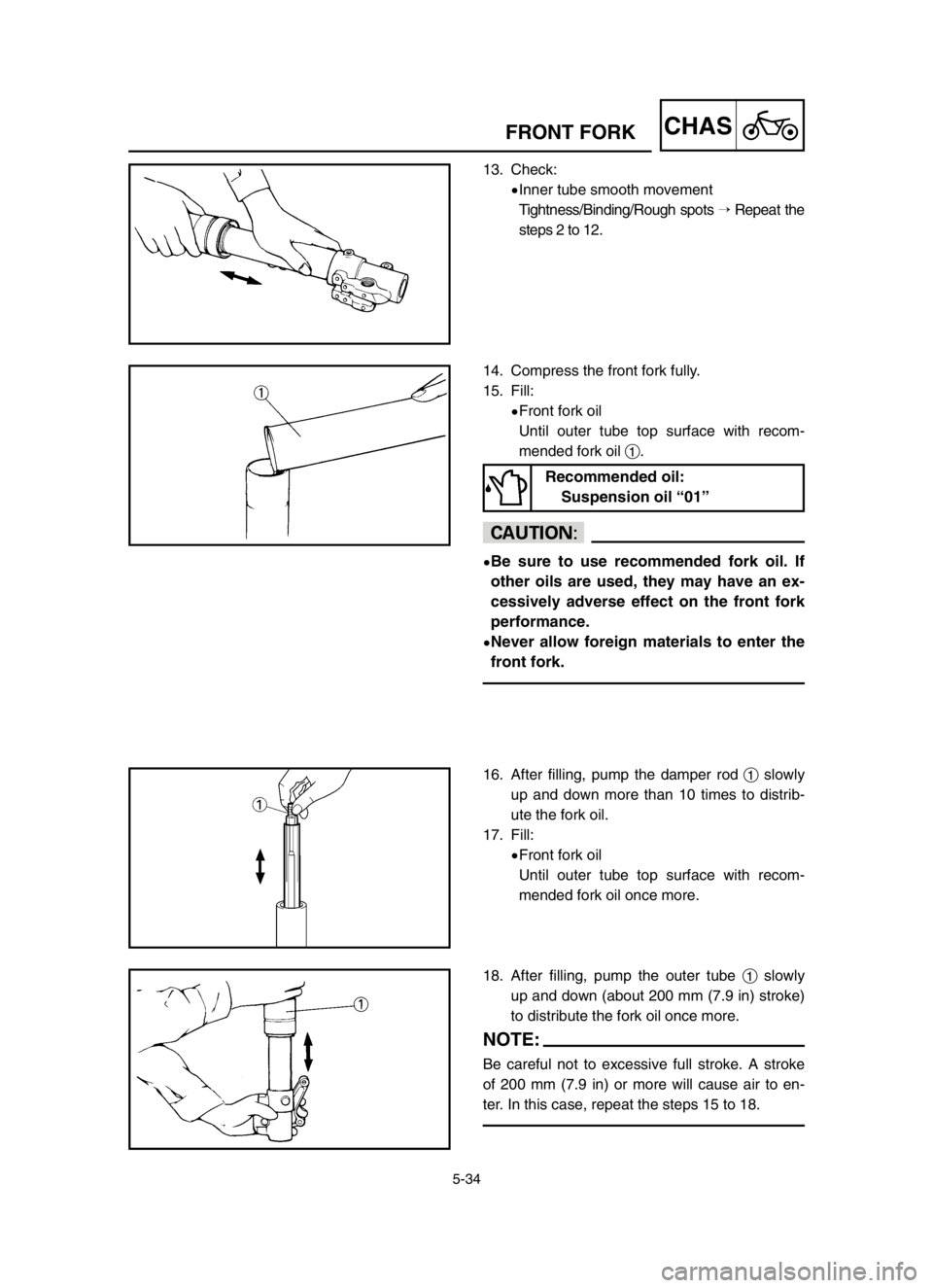Page 268 of 568
4-28
ENGCYLINDER HEAD, CYLINDER AND PISTON
3. Install:
9Nut (cylinder) 1
NOTE:
Tighten the nuts in stage, using a crisscross pat-
tern.
4. Install:
9Collar 1
9Push rod 2
9Plain washer 3
9Bolt (push rod) 4
NOTE:
9Set the collar 5included in owner's tool kit to
install the bolt (push rod).
9Do not forget to remove the collar.
EC4753A2
Cylinder head and cylinder
1. Apply:
9Engine oil
To piston 1, piston ring 2and cylinder
surface.
2. Install:
9Cylinder 1
cC
Make sure the piston ring is properly posi-
tioned. Install the cylinder with one hand
while compressing the piston ring with the
other hand.
NOTE:
After installing, check the smooth movement of
the piston.
30 Nm (3.0 m•kg, 22 ft•lb)
5 Nm (0.5 m•kg, 3.6 ft•lb)
5XE-9-30-4B 3/24/03 11:18 PM Page 22
Page 348 of 568
4-68
ENGCRANKCASE AND CRANKSHAFT
6. Install:
9Holder 1
9Bolt (holder) 2
7. Install:
9Segment 1
9Bolt (segment) 2
NOTE:
9When installing the segment onto the shift cam
3, align the punch mark awith the dowel pin
b.
9Turn the segment clockwise until it stops and
tighten the bolt.
8. Remove:
9Sealant
Forced out on the cylinder mating surface.
9. Apply:
9Engine oil
To the crank pin, bearing, oil delivery hole
and connecting rod big end washer.
10. Check:
9Crankshaft and transmission operation
Unsmooth operation �Repair.
30 Nm (3.0 m•kg, 22 ft•lb)
10 Nm (1.0 m•kg, 7.2 ft•lb)
5XE-9-30-4D 3/24/03 11:14 PM Page 24
Page 354 of 568
4-71
ENGTRANSMISSION, SHIFT CAM AND SHIFT FORK
EC4H4801
Shift fork, shift cam and segment
1. Inspect:
9Shift fork 1
Wear/Damage/Scratches �Replace.
2. Inspect:
9Shift cam 1
9Segment 2
9Guide bar 3
Bend/Wear/Damage �Replace.
3. Check:
9Shift fork movement
On its guide bar.
Unsmooth operation �Replace shift fork
and/or guide bar.
NOTE:
For a malfunctioning shift fork, replace not only
the shift fork itself but the two gears each adja-
cent to the shift fork.
EC4H5000
ASSEMBLY AND INSTALLATION
EC4H5213
Transmission
1. Install:
95th pinion gear (23T) 1
93rd pinion gear (19T) 2
94th pinion gear (19T) 3
92nd pinion gear (15T) 4
To main axle 5.
NOTE:
9Apply the molybdenum disulfide oil on the 4th
and 5th pinion gears inner circumference and
on the end surface.
9Apply the molybdenum disulfide oil on the 2nd
and 3rd pinion gears inner circumference.
5XE-9-30-4D 3/24/03 11:14 PM Page 30
Page 428 of 568

5-34
CHASFRONT FORK
13. Check:
9Inner tube smooth movement
Tightness/Binding/Rough spots �Repeat the
steps 2 to 12.
14. Compress the front fork fully.
15. Fill:
9Front fork oil
Until outer tube top surface with recom-
mended fork oil 1.
cC
9Be sure to use recommended fork oil. If
other oils are used, they may have an ex-
cessively adverse effect on the front fork
performance.
9Never allow foreign materials to enter the
front fork.
16. After filling, pump the damper rod 1slowly
up and down more than 10 times to distrib-
ute the fork oil.
17. Fill:
9Front fork oil
Until outer tube top surface with recom-
mended fork oil once more.
18. After filling, pump the outer tube 1slowly
up and down (about 200 mm (7.9 in) stroke)
to distribute the fork oil once more.
NOTE:
Be careful not to excessive full stroke. A stroke
of 200 mm (7.9 in) or more will cause air to en-
ter. In this case, repeat the steps 15 to 18.
Recommended oil:
Suspension oil “01”
5XE-9-30-5B 4/30/03 9:41 AM Page 18
Page 430 of 568

5-35
CHASFRONT FORK
19. Wait ten minutes until the air bubbles have
been removed from the front fork, and the
oil has dispense evenly in system before
setting recommended oil level.
NOTE:
Fill with the fork oil up to the top end of the outer
tube, or the fork oil will not spread over to every
part of the front forks, thus making it impossible
to obtain the correct level.
Be sure to fill with the fork oil up to the top of the
outer tube and bleed the front forks.
20. Measure:
9Oil level (left and right) a
Out of specification � Adjust.
NOTE:
Be sure to install the spring guide 2when
checking the oil level.
w
Never fail to make the oil level adjustment
between the maximum and minimum level
and always adjust each front fork to the
same setting. Uneven adjustment can
cause poor handling and loss of stability.
Standard oil level:
125 mm (4.92 in)
Extent of adjustment:
105~135 mm (4.13~5.31 in)
From top of outer tube with
inner tube and damper rod
1 1
fully compressed without spring.
5XE-9-30-5B 4/30/03 9:41 AM Page 20
Page 492 of 568
6-2
ELECIGNITION SYSTEM
EC620000
IGNITION SYSTEM
EC621003
INSPECTION STEPS
Use the following steps for checking the possibility of the malfunctioning engine being attributable to
ignition system failure and for checking the spark plug which will not spark.
*Clean or replace
spark plug.
Primary coil
Secondary coil
Repair or replace.
Spark
Check entire ignition
system for connection.
Spark gap test
No good
No good
No good
No good
No good
No good No Spark
Check “ENGINE STOP”
button.
Pick-up coil
Source coil
Check ignition coil.
Check CDI magneto.
Replace CDI unit.
Replace.
Replace.
Replace.
Replace.
Replace.
*marked: Only when the ignition checker is used.
NOTE:
9Remove the following parts before inspection.
1) Seat
2) Fuel tank
9Use the following special tools in this inspection.
Dynamic spark tester:
YM-34487
Ignition checker:
90890-06754Pocket tester:
YU-3112-C/90890-03112
OK
OK
OK
OKReplace.
Check spark plug cap.No good
OK
5XE-9-30-6 4/15/03 11:33 AM Page 4
Page 502 of 568
6-6
ELECIGNITION SYSTEM
3. Inspect:
9Source coil 2 resistance
Out of specification �Replace.
EC628000
CDI UNIT INSPECTION
Check all electrical components. If no fault is
found, replace the CDI unit. Then check the
electrical components again.
Tester (+) lead�Green/Blue lead 1
Tester (–) lead
�Black lead 2
Source coil 2 Tester selector
resistance position
44~66Ωat
Ω× 10
20°C (68°F)
5XE-9-30-6 4/15/03 11:33 AM Page 14
Page 504 of 568

7-1
TUNSETTING
EC700000
TUNINGEC710000
ENGINEEC711001
Carburetor setting
9The role of fuel is to cool the engine, and in the
case of a 2-stroke engine, to lubricate the
engine in addition to power generation.
Accordingly, if a mixture of air and fuel is too
lean, abnormal combustion will occur, and
engine seizure may result. If the mixture is too
rich, spark plugs will get wet with oil, thus mak-
ing it impossible to bring the engine into full play
or if the worst comes to the worst, the engine
may stall.
9The richness of the air-fuel mixture required for
the engine will vary with atmospheric conditions
of the day and therefore, the settings of the car-
buretor must be properly suited to the atmos-
pheric conditions (air pressure, humidity and
temperature).
9Finally, the rider himself must make a test-run
and check his machine for conditions (pick-up
of engine speed, road surface conditions) and
for the discoloration of the spark plug(s). After
taking these into consideration, he must select
the best possible carburetor settings.
It is advisable to make a note of settings,
atmospheric conditions, road surface condition,
lap-time, etc. so that the memorandum can be
used as a reference useful for future.
EC712000
Atmospheric conditions and carburetor
setting
The reason for the above tendency is that the
richness or leanness of a fuel mixture depends
on the density of the air (i.e. the concentration of
oxygen in it).
Air
Air temp. Humidity pressure Mixture Setting
(altitude)
High HighLow
Richer Leaner
(high)
Low LowHigh
Leaner Richer
(low)
5XE-9-30-7A 4/30/03 9:39 AM Page 2